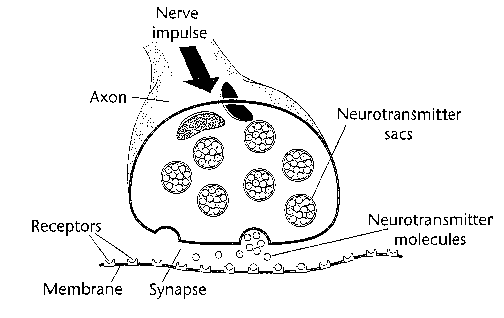
Read pp 601 & 605-606
See Figures:
30-3
30-4
30-6
30-9
Table 30-1
Neurons: 'Wiring' of Nervous System (N.S.). A cell that carrys messages throughout N.S. .
1. Dendrites: Look like branches. Receives messages, carries them to the cell body.
2. Cell Body: Enlarged part of neuron. Contains nucleus, many mitochondrion, most other organelles.
3. Axon: Long thin fiber carrying impulses away from cell body.
4. Axon Terminals: Small, branched axon fibers at end of axon.
5. Myelin Sheath: Fatty insulation around axons to help keep electrical impulses from jumbing to neighboring neurons & "shorting" them out!
6. Synapse: Tiny gap ('break' in circuit) between axon terminals & dendrites of next neuron. Neurotransmitters (chemicals) transmit impulse across the gap.

Impulses (electrical activity) always move from
dendrite--->cell body--->axon--->axon terminal--->synapse--->dendrite of next neuron.


Impulse: Electrical activity moving along neuron.
Threshold: All or none principal. If stimulus is too weak, no impulse is started. If stimulus is stronger than threshold, the impulse starts.
Resting potential: difference in electrical charge across a neuron cell membrane (positive outside & negative inside). Results from fact K+ leaks out faster than Na+ moves in, so + charge builds up outside (- charge inside).
Depolarization: Stimulus causes pumps to move Na+ inside, causing inside to become +. This is beginning of impulse. This causes next pump to move Na+ in,.. etc., so impulse moves.
Repolarization: After Na+ moves in, the pump moves K+ out, to reset neuron with + charge outside, - charge inside. Last action of repolarization moves K+ back in, and Na+ out. This takes a split second, so impulse is only able to move 1 direction.
Action Potential: Changes in the + or - balance (where the Na+ is) of the neuron membrane that results in an impulse.